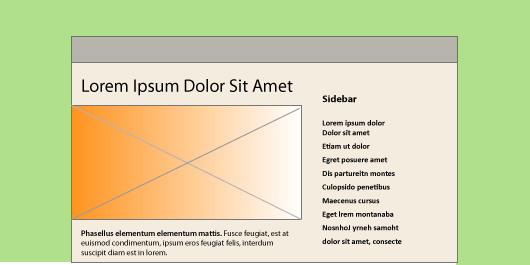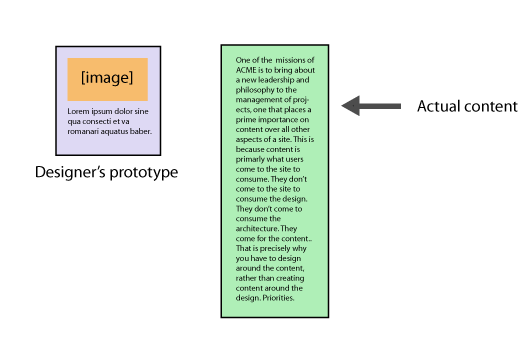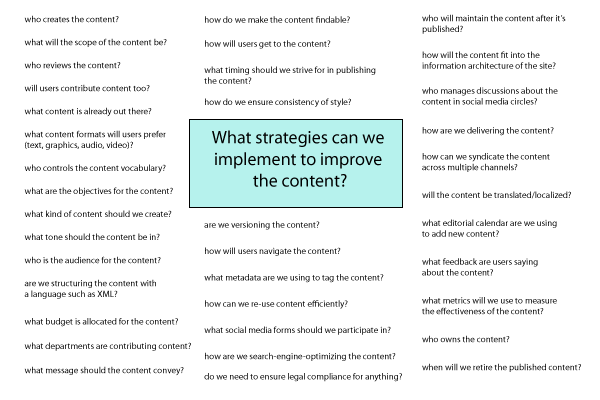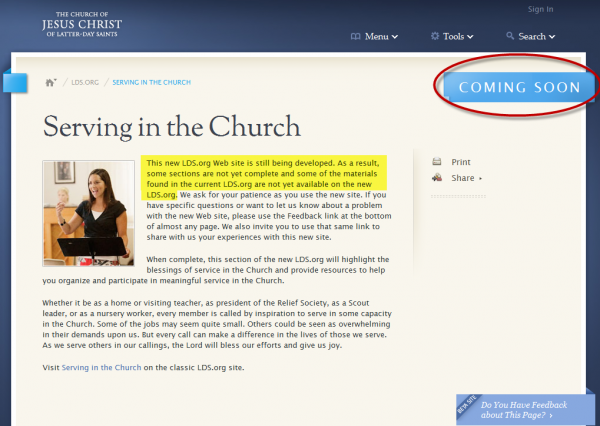The Increasing Momentum of Content Strategy
Content strategy is a topic more and more technical communicators are talking about. It's one of the dominant conversations in the field right now. David Farbey recently presented on Content Strategy for Everyone at Tech Comm UK. Rahel Bailie talked about Creating a Content Strategy at the Lavacon conference. Scott Abel continually talks about content strategy -- see this video series on content strategy he did with MindTouch.
When I was in Atlanta a while ago, Rachel Peters and Will Sansbury were raving about content strategy. They even talked about a new content strategy meetup they started attending in Atlanta. Unlike previous Summits, the last STC Summit had a handful of sessions on content strategy:
- Content Strategies: The Content Lifecycle
- There's No Semantic Web Without Content and Data
- Developing a Structured Content Strategy
- The Path to Implementing Content Strategy
- Content Strategy SIG Progression
There's a Content Strategy SIG. MindTouch recently announced a list of the top 25 content strategists. And now Kristina Halverson, author of Content Strategy for the Web, has announced an upcoming conference on content strategy.
Content strategy is clearly gaining momentum as a discipline alongside other disciplines related to tech comm, such as content management, information architecture, usability, and information design. And yet, many people feel that content strategy is vague, unclear, and frustrating in scope. In Contente, Nicol Jones writes,
One of my dearest friends (Katrina Dickson) e-mailed me at 2:38 a.m. on Thursday about content strategy.
Although she reads my posts and other content-related blogs, we haven't discussed this before, other than talking about my role change when I left Apple in May. We usually just talk about food, cocktails, boys, San Francisco, et cetera.
Her questions were specific, her opinions were strong, and reading her note while waking up made my day.
To summarize her comments, she said she finds a lot of the posts about content strategy to be “frustratingly vague” and often repetitious. Definitions are unclear or incomplete. There's too much junk on the pile. Kat's most astute comment was:
If we thought of content strategy as a brand, it would be in some dire need of content strategizing. (A Brief Prolegomenon)
In other words, content strategy is hard to understand and implement; it's too massive in scope to be clear. Ironically, it seems to lack content appeal itself.
The Classic Scenario
Exactly what is content strategy? Let's look at what happens when there's no content strategy. Here's a classic scenario that you're probably familiar with. You're working on a new company website. Your interaction designer creates fancy prototypes filled with Latin text that look like this:

The prototypes lack real content. The designer just inserts filler text in places where he or she thinks content will later appear. In this particular prototype, the designer accommodates a few sentences of text and relies on a large image as the central focal point.
When it's time to add the real content, you submit a lengthy block of text with no images at all, like this:

Consequently, you have a mismatch between the prototypes and content. It's as if the designer has created packaging that doesn't fit the product, and now you have the issue of figuring out how to send it.
Has this ever happened to you? If so, content strategy is probably relevant to you. Content strategy attempts to re-prioritize content so that it's the focus of the project from day one, so that the designers create prototypes based on the content, not the other way around.
More Formal Definitions
The preceding example underscores the priority that content should have in a project. But we need a more formal definition of content stratgy. Kristina Halverson says "content strategy plans for the creation, publication, and governance of useful, usable content" (The Discipline of Content Strategy).
Rahel Bailie describes content strategy as a "repeatable system that governs the management of content throughout the lifecycle" (Content Strategy Presentation at Lavacon).
Scott Abel says content strategy is a "systematic approach involving automation, standardization, and productivity" (Why Content Strategy Matters).
These definitions capture the scope of the content strategist's purpose. Ultimately the content strategist's central question is this: what strategies can I implement to improve the content? Everything else in the preceding definitions -- the creation, publication, governance, usefulness, standardization, automation, and management of content -- are all just strategies aimed at improving the content.
Halverson notes that many people postpone discussions of content because content is messy and complicated. In fact, when we look at content from all the angles that need to be discussed and planned, we have to answer many of the questions in the following graphic:

The central purpose of each strategy should be geared toward content improvement, toward eradicating content that fails for users. (By content, we mean text, video, audio, and graphics.)
Although the ultimate goal is to improve the content, the focus of the content strategist is more on implementing strategies and processes than creating content itself (although a content strategist may play both roles). Overall, the content strategist tries to fix the processes that led to poor content.
Good Resources on Content Strategy
For a good primer on content strategy, see these four resources (almost all from Kristina Halverson):
- The Discipline of Content Strategy, A List Apart, by Kristina Halverson
- Kristina Halverson, Content Strategy: CreativeXpert Design Interviews (a podcast)
- Content Strategy for the Web, by Kristina Halverson
- Why Content Strategy Matters: A Video Series Interview with Scott Abel, by MindTouch
Discussions About Content Strategy Need Better Content
Ironically, discussions about content strategy seem a bit dry, as Nicol Jones' friend pointed out. I think Kristina Halverson's book, Content Strategy for the Web, is a seminal book for the emerging discipline of content strategy. She lays out the core principles of content strategy in a clear, easy-to-follow way. She made me see all the dimensions of content that I hadn't considered before. It's a quick read with an engaging, witty voice.
But it lacks stories of real-world situations that were transformed through content strategy. Without the substance of story, without anecdotes and case studies and examples to illustrate the concepts and principles of content strategy, the content fails to make more meaningful connections with readers.
Most discussions of content strategy I've encountered follow the same style: a lot of abstract principles and concepts, with few concrete examples and stories. Kristina even says near the end of the book,
At the time of this writing, I'm not aware of a single case study available to the public that documents a content strategy success story. This, of course, is a problem. If there were a Forrester report that provided charts and data and Venn diagrams about how content strategy has demonstrated measurable ROI (return on investment) in dozens of organizations, we'd all have a much easier time selling content strategy into our companies. But there's not. (Content Strategy for the Web, p.171)
Without the substance of real-world examples and concrete illustrations of content strategy, how can the discipline of content strategy ever move away from being vague and feeling incomplete?
A Story for Content Strategy
One of the problems with telling stories or providing examples is exposure of client details. This is problematic with blogging in general. But the blogger/writer must tactfully walk the line between appropriate and inappropriate exposure of details in any stories he or she tells.
With that said, I have a good story that illustrates the need for content strategy. I'm a technical writer for a large organization, the LDS Church. We have millions of users/members worldwide, and thousands of employees, with dozens of departments. We recently began a redesign of the existing lds.org into a new, more contemporary looking site. You can view the beta at new.lds.org.
Interaction designers worked hard to come up with comps and prototypes for the new site. We probably have half a dozen or more interaction designers working on the site. On the floor where the interaction designers are grouped, they pin up prototypes of the new site all along the walls. It's almost like touring a gallery or museum. You can stop and look at one printout, and then move to the next, doing so for much of the afternoon. Their work is visually stunning.
The target launch, I believe, was sometime around October. I'm not totally sure, because I'm not very involved with the redesign. But a few months ago, as they had settled on a design, our team (User Education) was approached about possibly writing content for the new site. Although they didn't have exact design prototypes for our content, I'm pretty sure the prototypes would have looked just like the other prototypes they created.
Our focus was to create information about each of the various organizations within the Church, such as Sunday School, Young Mens, Relief Society, Primary, and so on. The old site had much of this content, but it needed updating, possibly an overhaul of voice and tone, and other fixes before we migrated it to the new site.
Apparently the bulk of the site redesign focused on the design, not the content. Granted, Audiovisual did create a lot of new multimedia content, and there were other aspects of the new site that were freshly written. But overall it seemed like content took a backseat to design. I believe product managers focused more on the shade of blue, whether the new site would have a slide gallery or not, whether it would use flash, how we would hook into the new content management system, how we would integrate single sign on, what icons and size of the thumbnails we would use, the fonts, the heading sizes, the search, the visibility on the iPad, the sidebar gradients, the share-this-content features, and the various site tools rather than the actual content (at least the text content).
For months teams met and deliberated over designs for the new site. It went through several iterations. But no one seemed to be focusing on the content itself (other than the videos audiovisual contributed). In fact, many of the pages in the existing lds.org site (the old site) just link to pages in the previous redesign (an even older site), because no one bothered to update the content from the previous redesign.
With each new redesign, we just keep lugging the previous content into the new model, kind of like moving clothes from one dresser to the next. The clothes may have a new dresser, but the clothes themselves are worn and ragged, out of style, and in need of repair.
Although our team was asked to do some last minute content development for the new site, two weeks into it, someone mysteriously asked us to pause our work (and never resumed it). I can only guess that whoever made the call to pause us realized the scope of the content. There are a lot of different departments involved, with senior leaders over each department. You can't just copywrite your way out of it one night. You have to meet with a lot of different groups, find out what content they need/want, and then write it -- all with the same voice and style and branding. Then you need to get it approved and published -- and hope that it will fit into the prototypes! Kind of an impossible task.
The site is nearly complete, and yet it still lacks content. Here's that section we were going to write.

I wish I could say that I stepped in and performed the content strategist's role, but actually I don't even know who pushed the pause button, or who is truly managing the project. More than 100 people are involved, and trying to find answers can be like playing pinball in the phone tree. You're referred from one person to another, and when you do finally meet someone who seems like the leader, you find that his or her approval doesn't carry weight because other people are moving in other directions, and you don't have billing codes for anything.
In this situation, a content strategist should have been involved early on. The content strategist should have gathered the content before the interaction designers started designing containers for the content. The content strategist should have mapped out a plan for the creation, review, and approval of the content. The content strategist should have been working closely with information architects to define the site navigation and flow of information. Instead, we ended up with a lot of prototypes without any real content, and filler pages like the above (which are essentially Latin text translated into kind English).
Conclusion
With smaller projects or non-website projects, you can play the role of a content strategist while performing your usual role. But with larger projects, a dedicated content strategist role is critical, particularly when you have multiple departments involved and a lot of content.
The content strategist should ask all the questions I included in my earlier graphic. But to be an effective content strategist, you also need to have a tremendous political/persuasive power to interact among various departments and project owners, to discover content needs and extract information from subject matter experts. You have to distill large scale messaging and brand, and then bring this all together while working closely with information architects and interaction designers to align their creativity with the content.
In short, the content strategist's role requires you not only to wrangle an immense amount of content into one unified whole, but also to wrangle and guide large groups of stakeholders and other decision leaders toward the same end.
About Tom Johnson

I'm an API technical writer based in the Seattle area. On this blog, I write about topics related to technical writing and communication — such as software documentation, API documentation, AI, information architecture, content strategy, writing processes, plain language, tech comm careers, and more. Check out my API documentation course if you're looking for more info about documenting APIs. Or see my posts on AI and AI course section for more on the latest in AI and tech comm.
If you're a technical writer and want to keep on top of the latest trends in the tech comm, be sure to subscribe to email updates below. You can also learn more about me or contact me. Finally, note that the opinions I express on my blog are my own points of view, not that of my employer.

